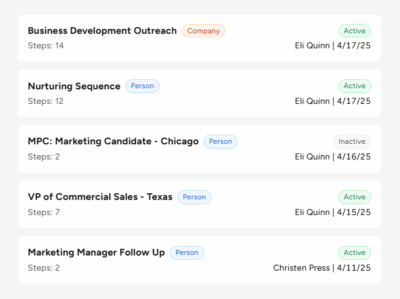Has a client ever rejected your candidates because they didn’t see how the workers fit the position? Or, have you ever sent a resume to a client only to have them ask for more information?
If you’ve experienced either of those situations, you could benefit from well-written candidate profiles.
Why you need excellent candidate profiles
Resumes only let you see basic, stripped down information about candidates. You get the bare bones of skills, experience, and education. Before sending resumes to a client, consider candidate profiles instead. Candidate profiles give a more robust image of the candidates. While a job candidate profile has information from the resume, the profile gives more detail about who a candidate really is beyond bullet points.
The goal of a recruiter profile of a candidate is to show your client that your candidates display good job fit for the open position. You can use the candidate summary to persuade your client. If your client likes what they see, your candidates can move further into the interview process, and you move closer to making a placement.
What to include in a candidate profile
You need to include some specific things to craft a persuasive candidate profile. The profile should contain relevant parts of the resume, your recommendation, and any other details that might help convince your client to interview the candidate.
Each part below explains what to include in the sections of the candidate profile. There are questions that can help you write a profile, and examples of what each section might look like. Feel free to use the information below as a recruitment candidate profile template.
1. Your impression of the candidate
At the beginning of the job candidate profile, you should state why you are recommending the candidate. Tell the client why the candidate impressed you.
This introduction to the candidate should hook your client to read more. Briefly say what makes this candidate stand out. You don’t want to give too many details yet, as those will come later.
Questions you might want to answer in this section of the candidate summary include:
- What made the candidate stand out?
- What qualities are immediately noticeable?
- How did the candidate present themself?
- What is the candidate passionate about?
- Why are you recommending this candidate?
Example: Sara is a bright individual. She came across as professional during all our conversations. She spoke competently and confidently about her experience as a staff accountant.
2. Relevant skills and experience
In this next section, you should talk about the candidate’s skills, experience, and education. Unlike a resume, you do not need to list the candidate’s entire background. Just talk about the things that specifically relate to the job.
Think about the candidate’s career knowledge and achievements. What things could you list that would impress your client? Make sure the summary highlights things your client requested in a candidate, otherwise you will waste your client’s time and won’t make the sendout.
Questions you might want to answer in this section include:
- What relevant education or training does the candidate have?
- Did the candidate have prior work experiences that relate to the job?
- What skills can the candidate perform?
- What awards or recognition has the candidate received?
Example: Sara has two bachelor’s degrees, one in accounting and one in business management. She also earned the Certified Management Accountant credential.
Sara has worked as a corporate accountant for the past seven years. She has experience working both independently and as a leader for two additional team members.
At her current position, Sara designed a plan to help the company save 10% this year by cutting miscellaneous spending. Based on our conversations, Sara seems to enjoy looking for ways to make a business more financially sound.
3. Notes from references
Sometimes, you might be able to talk to a candidate’s references. Getting information during a reference check can build credibility for a candidate because you have an additional person vouching for the worker.
The section about the reference does not have to be long. You do not have to include everything that the reference said. Instead, include highlights and maybe a standout quote. If you do not talk to references, you can exclude this section.
Questions you might want to answer in this section include:
- How does the reference know the candidate?
- What did the reference say about the candidate’s skills?
- What did the reference say about the candidate’s personal qualities?
Example: I was able to speak to one of Sara’s current coworkers who has worked with her for the past four years. Sara’s coworker described her as someone who is “not afraid to make tough decisions, especially if it will benefit the people around her.” The coworker also said Sara is easy to work with and has sharp accounting skills.
4. Compensation expectations
It’s good to be clear about salary expectations upfront. If the client and candidate are mismatched and unwilling to compromise, there’s no point in continuing with the candidate. By telling the client about the candidate’s desired compensation, you avoid wasting everyone’s time in the future.
If a candidate and client do not match up with compensation expectations, don’t be afraid to still create a profile for the candidate. The candidate and client might be willing to negotiate.
Questions you might want to answer in this section include:
- How much does the candidate currently earn?
- What does the candidate expect to earn at the new position?
- Are there other types of compensation to consider?
Example: At her current job, Sara earns a salary of $50,000. She would like to at least match this amount.
5. Availability
Let your client know when each candidate is available to start work. For some clients, this might be an important factor in which candidate they pick. If a candidate cannot start work for a while, that might be a turnoff for some clients.
Questions you might want to answer in this section include:
- When is the soonest a candidate start?
- Is there anything preventing the candidate from starting sooner?
Example: Sara is required to give a two weeks notice at her current job. She is available to begin work at any time after the two weeks are complete.
6. Recap
Do you remember in school how teachers said you need to wrap up your papers with a conclusion? The recap section of the candidate profile is similar to the conclusion.
Once again, state why you are recommending the candidate. Give an overview of why the candidate is a good fit for the job. Then, give any other remarks that might help the client make their decision.
Questions you might want to answer in this section include:
- Why are you recommending the candidate?
- Why is the candidate qualified?
- Is there anything else the client should know about the candidate?
Example: Of all the candidates I spoke with, Sara seemed like the best fit for the position. She clearly knew what she was talking about. Her experience and her reference both show that she is a skilled decision maker and knowledgeable accountant.
How to create a candidate profile
You know what needs to go into a candidate profile, but where does that information come from?
You can get most of this information in your applicant tracking system. You should have each candidate’s resume parsed into your system. Use the resume information in your ATS in the candidate summary.
Conversations with candidates give more depth of character than a resume does. You should keep notes in your ATS software about each candidate. Every time you talk to or interview a candidate, enter the things the candidate said. Use your notes to fill in the candidate profile.









